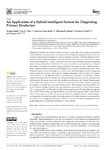Mostrar o rexistro simple do ítem
An application of a hybrid intelligent system for diagnosing primary headaches
| dc.contributor.author | Simić, Svetlana | |
| dc.contributor.author | Villar, José R. | |
| dc.contributor.author | Calvo-Rolle, José Luis | |
| dc.contributor.author | Sekulić, Slobodan R. | |
| dc.contributor.author | Simić, Svetislav D. | |
| dc.contributor.author | Simić, Dragan | |
| dc.date.accessioned | 2021-03-29T11:33:26Z | |
| dc.date.available | 2021-03-29T11:33:26Z | |
| dc.date.issued | 2021 | |
| dc.identifier.citation | Simić, S.; Villar, J.R.; Calvo-Rolle, J.L.; Sekulić, S.R.; Simić, S.D.; Simić, D. An Application of a Hybrid Intelligent System for Diagnosing Primary Headaches. Int. J. Environ. Res. Public Health 2021, 18, 1890. https://doi.org/10.3390/ijerph18041890 | es_ES |
| dc.identifier.issn | 1661-7827 | |
| dc.identifier.uri | http://hdl.handle.net/2183/27630 | |
| dc.description.abstract | [Abstract] (1) Background: Modern medicine generates a great deal of information that stored in medical databases. Simultaneously, extracting useful knowledge and making scientific decisions for diagnosis and treatment of diseases becomes increasingly necessary. Headache disorders are the most prevalent of all the neurological conditions. Headaches have not only medical but also great socioeconomic significance. The aim of this research is to develop an intelligent system for diagnosing primary headache disorders. (2) Methods: This research applied various mathematical, statistical and artificial intelligence techniques, among which the most important are: Calinski-Harabasz index, Analytical Hierarchy Process, and Weighted Fuzzy C-means Clustering Algorithm. These methods, techniques and methodologies are used to create a hybrid intelligent system for diagnosing primary headache disorders. The proposed intelligent diagnostic system is tested with original real-world data set with different metrics. (3) Results: First at all, nine of 20 attributes – features from International Headache Society (IHS) criteria are selected, and then only five most important attributes from IHS criteria are selected. The calculation result based on the Calinski–Harabasz index value (178) for the optimal number of clusters is three, and they present three classes of headaches: (i) migraine, (ii) tension-type headaches (TTHs), and (iii) other primary headaches (OPHs). The proposed hybrid intelligent system shows the following quality metrics: Accuracy 75%; Precision 67% for migraine, 74% for TTHs, 86% for OPHs, and Average Precision 77%; Recall 86% for migraine, 73% for TTHs, 67% for OPHs, Average Recall 75%; F1 score 75% for migraine, 74% for TTHs, 75% for OPHs, and Average F1 score 75%. (4) Conclusions: The hybrid intelligent system presents qualitative and respectable experimental results. The implementation of existing diagnostics systems and the development of new diagnostics systems in medicine is necessary in order to help physicians make quality diagnosis and decide the best treatments for the patients. | es_ES |
| dc.description.sponsorship | Ministerio de Ciencia e Innovación; MINECO-TIN2017-84804-R | es_ES |
| dc.description.sponsorship | Gobierno del Principado de Asturias; FCGRUPIN-IDI/2018/000226 | es_ES |
| dc.description.sponsorship | Serbia. Ministry of Education, Science and Technological Development; 451-03-68/2020-14/200156 | es_ES |
| dc.language.iso | eng | es_ES |
| dc.publisher | MDPI | es_ES |
| dc.relation.uri | https://doi.org/10.3390/ijerph18041890 | es_ES |
| dc.rights | Creative Commons License Attribution 4.0 (CC BY 4.0) | es_ES |
| dc.rights.uri | http://creativecommons.org/licenses/by/3.0/es/ | * |
| dc.subject | Intelligent system | es_ES |
| dc.subject | Headaches | es_ES |
| dc.subject | Analytical hierarchy process | es_ES |
| dc.subject | Fuzzy c-means clustering | es_ES |
| dc.title | An application of a hybrid intelligent system for diagnosing primary headaches | es_ES |
| dc.type | info:eu-repo/semantics/article | es_ES |
| dc.rights.access | info:eu-repo/semantics/openAccess | es_ES |
| UDC.journalTitle | International Journal of Environmental Research and Public Health | es_ES |
| UDC.volume | 18 | es_ES |
| UDC.issue | 4 | es_ES |
| UDC.startPage | 1 | es_ES |
| UDC.endPage | 14 | es_ES |
| dc.identifier.doi | https://doi.org/10.3390/ijerph18041890 |
Ficheiros no ítem
Este ítem aparece na(s) seguinte(s) colección(s)
-
GI-CTC - Artigos [80]






